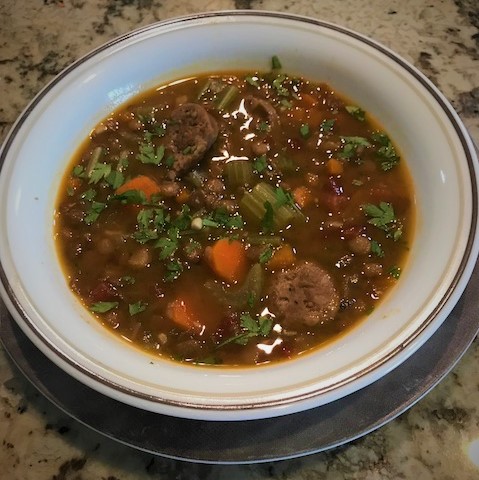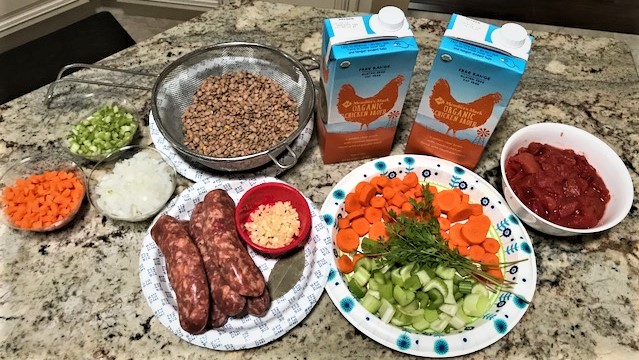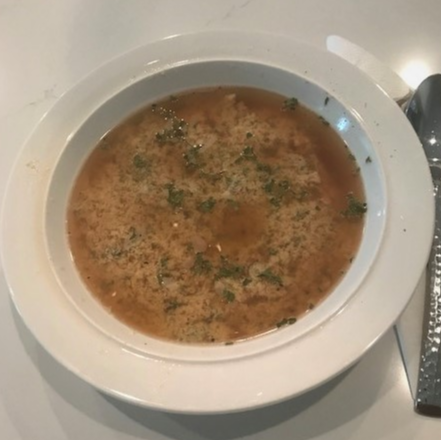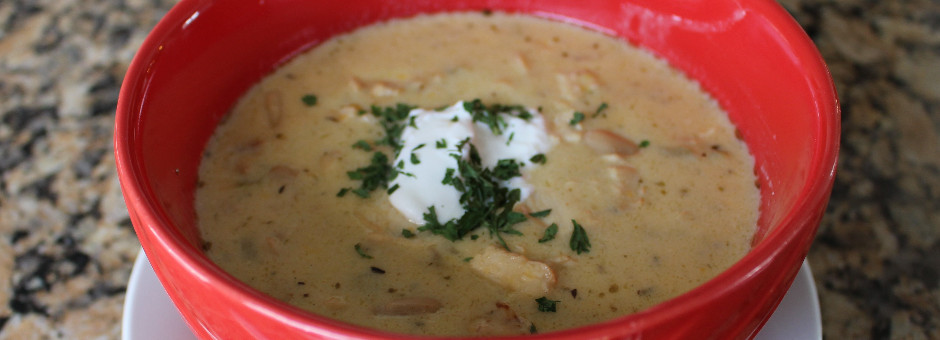Soups, Stews, Chili and Chowders
- 2 chicken breasts with skin, breast meat and bones (legs can be used although I prefer white meat). You can also add any saved wings, neck or back bones)
- 3 unpeeled but washed medium carrots each broken into 3 or 4 pieces
- 3 large outer celery stalks with leaves also broken into pieces
- 1 Spanish onion halved
- 1 tablespoon dried Italian seasoning
- 1 teaspoon Tuscany seasoning Several parsley
- 1 bay leaf
- 4 to quarts of water Soup About
- 5 peeled medium carrots
- About 4 outer celery stalks
- 2 32 oz. boxes (or more) store bought quality low salt chicken broth
- 1/2 cup coarsely chopped flat leafed parsley "Better Than Bouillon, Roasted Chicken Base" as desired
.jpg)
- 1 Whole, 2 split chicken breasts with skin and bones
- Olive oil
- Tuscany Seasoning (Rosemary, sage, garlic, and kosher salt), or favorite poultry seasoning
- 1-pound carrots
- 8 Large celery stocks
- Fresh flat Italian parsley
- 1 medium yellow onion
- 3 32 oz. boxes chicken broth
- 10-oz package of fresh spinach
- “Better than Bouillon” Chicken, Roasted Chicken Base, or Premium Base°
.jpg)
- 2½ to 3 pounds chuck beef
- Salt and fresh ground pepper
- Cooking oil (vegetable or another favorite)
- 1 medium yellow onion sliced
- 2 garlic cloves sliced
- 2-3 medium plum tomatoes, 2 T tomato paste, etc.
- ¼ cup flour
- 1 ½ cup red wine
- 1 32 oz box low salt chicken broth.
- 2 bay leaves
- 2 teaspoon favorite European style seasoning/spice blends (1)
- 4-5 medium red potatoes
- 1-pound large carrots
- 1 cup frozen peas (optional)
- 3 Tablespoons minced parsley
- 1 tablespoon vegetable/canola oil
- ½ cup chopped scallions or medium onion
- 2 14.5-oz cans chicken broth
- 2 9-oz packages of cooked chicken breasts (i.e. Perdue “Short Cut Carved Chicken Breast” or similar) cut into smaller pieces
- 2 15½ oz. cans white beans (cannellini, great northers, etc.)
- 1 ½ teaspoons garlic powder
- 1 4-oz. can green chili
- 1 teaspoon ground cumin
- 1 teaspoon dried oregano
- 1 teaspoon salt
- ½ teaspoon white pepper
- ¼ teaspoon cayenne pepper
- 1 cup sour cream
- 1 8-oz package (2 cups) shredded cheddar or pepper jack cheeses

- 2-large sweet potatoes
- 1 medium acorn squash (1)
- 1 pound carrots
- 4-6 ears sweet corn
- 6-8 Boneless and skinless chicken thighs (about 2 lbs.)
- ¼ pound cubed pancetta
- 2 32oz containers chicken broth (or more as needed.
- ¼ teaspoon cumin
- ¼ teaspoon fresh nutmeg
- 1 teaspoon Herbes de Provence spice blend
- Better Than Bouillon™ Roasted Chicken Base
- Salt and white pepper
- Fat Free sour cream
- Dry sherry, optional
- Cayenne pepper, optional
Bold Roasted Vegetable Soup with Pureed Acorn Squash, Sweet Potato and Carrot
-c20ad.jpg)
This rich and creamy soup also starts with charred roasted vegetable seasoned with blend. Soup is also flavored with sautéed pancetta, fresh ground nutmeg, salt, white pepper and is sweetened with brown sugar.
Cream cheese adds rich texture. The soup is thinned with chicken broth and served with a dollop of sour cream.
Ingredients:
Charring vegetables
- 2-large sweet potatoes
- 1-pound carrots
- Olive oil
- 1 teaspoon Herbes de Provence spice
- 1 medium acorn squash
- 2 tablespoons softened butter
- 1 tablespoon brown sugar
Other ingredients
- ¼ pound cubed pancetta
- 2 32-oz chicken broth plus more if needed.
- 8-oz creamcheese*
- ¼ teaspoon fresh nutmeg
- Salt and white pepper
- Additional brown sugar
- Fat Free sour cream
Peel and cube sweet potatoes. Peel carrots and thick slice. Toss each with olive oil while sprinkling with Herbes de Provence spice. Oven roast single layer with 400°direct heat. Flip them over occasionally. Remove when soft and slightly caramalized.
Cut squash into four wedges; remove seeds. liberally brush with butter and sprinkle with brown sugar. Squash is also placed in oven, roasted with skin sides down. When ready skin easily peels off by hand.
While vegetables are roasting, create a wonderful flavor base by browning a quarter pound of finely cubed pancetta in a large finishing pot. Cover with chicken broth and simmer until vegetables are ready.
When vegetables are charred and squash’s pulp is very soft throughout eliminating bitterness, puree potato, carrots, and squash pulp with cream cheese, nutmeg, and remaining chicken broth. Mix into pot with pancetta. Reheat and finish by adding more broth if needed for desired thickness. Add salt, white pepper and brown sugar to taste.
Serve in individual cups or bowls with dollops of sour cream.
.jpg)
- 1 medium acorn squash
- 1 medium/large sweet potatoes
- 5 medium carrots
- Tuscany Seasoning (rosemary, sage, kosher salt and Garlic)
- Vegetable oil
- 24-oz medium or large shrimp
- 32-oz box seafood broth
- 2 8-oz bottles clam juice
- 8-oz fat free sour cream
- ¾ cup sherry
- ¼ teaspoon Old Bay Seasoning
- 4 tablespoons butter room temperature
- Kosher salt
Shrimp Chowder
-e4da3.jpg)
Our friends Evelyn and Larry Boman invited us for comfort food on a chilly Florida night (yes chilly Florida night!). As always, our hosts were gracious, menu well selected and food delicious.
Most special was Evelyn’s Shrimp Chowder. As New Englanders, Nancy and I know chowders and hers was terrific. Knowing I’d be blown away with its simplicity, she grinned as she handed me her detailed recipe card.
Preparations are minimal, ingredients mostly prepackaged, economical brands used, and assembly quite easy.
Evelyn said don’t be afraid to customize proportions to your taste. Adjust proportions of milk and cream for preferred consistency. Add more shrimp or alter spices and/or heat with pepper flakes. ¼ teaspoon of red pepper flakes proved perfect.
Her chowder was made earlier. Shrimp added and cooked just before we arrived.
Recipe makes about 9-cups.
Ingredients:
- 1 bunch green onions
- 2 T Butter
- ¼ - ½ teaspoon Red pepper flakes
- ¼ teaspoon garlic powder
- Pinch black pepper
- 8 oz. cream cheese, room temperature
- 3 10.5 oz. cans of condensed cream of potato soup*
- 1 10-14 oz. can whole corn drained
- 1 soup can of whole milk
- 1 soup can of heavy cream
- 10 oz. shelled frozen shrimp
- Oyster crackers
* Great Value brand or similar
Remove tips from green onions; coarsely chop
Sauté onion in butter until translucent. Add red, black pepper, and garlic powder. Lower heat.
Add cream cheese to the pot. Melt while mashing with a folk. Add a little milk if needed to help. Be careful not to burn.
Add condensed soup, corn, milk, and cream. Simmer while stirring until well combined.
Before company arrives, simmer with shrimp.
Chowder is ready when hot but not boiling and shrimp is just cooked through. Serve with oyster crackers. ENJOY!
Black Bean Soup
-c51ce.jpg)
Black beans cook pleasantly creamy. Although their natural flavor is mild, they absorb the flavorings they are simmered with. They are also high in protein.
Italians commonly use Battuta, a perfect flavor base for soups and braised meats. Mom used a trio of chopped carrot, celery and onions. She also included minced garlic and rendered salt pork. This recipe replaces salt pork either with pancetta (Italian salt cured bacon) or traditional bacon.
No need to dilute beans by soaking them in water but are simmered in chicken broth until beans reach your desired texture.
Options, instead of pancetta or bacon, try simmering soup with smoked pig’s knuckles, leftover ham bones, sausages, or a variety of other meats.
Ingredients:
- Olive oil
- 1-cup diced pancetta or bacon
Battuta
- 1 cup diced carrots
- 1 cup diced celery
- 1/2 cup diced onion
Other ingredients
- 4 large garlic cloves finely chopped
- 2 32 oz. boxes chicken broth (more if needed)
- 2 tablespoons tomato paste
- 2-teaspoon Italian seasoning
- 1 Bay leaf
- 1-pound dried black beans
- salt and pepper
- Sour cream
Lightly brown pancetta or crisp bacon in olive oil in a pot large enough to hold all ingredients. Set aside.
Sauté Battuta ingredients with additional oil while tossing. When softened, add garlic and cook for an additional minute. Stir in broth, tomato paste, Italian seasoning, and bay leaf.
While bringing to a boil, check beans for any debris. Place beans in a strainer and rinse.
When broth reaches a boil, stir in beans. Partially cover and adjust heat to a simmer. Add water or more broth as needed.
When beans are nearly ready, tender, about 2 hours, add pancetta or bacon. Adjust for seasoning, salt, and pepper
Serve with a dollop of sour cream.
.jpg)
- ½ ounce dried porcine mushrooms
- 2 pounds white or baby Bella mushrooms
- ¼ cup of oil oil and 1 large garlic clove)
- 1-14.4 oz. can chicken broth, regular or gluten free
- 3/4 cup sherry equally divided
- ¼ teaspoon dry Tarragon or ½ teaspoon fresh.
- 6 tablespoon butter
- 1 32-ounce, quart container of chicken broth, regular or gluten free
- 1 cup heavy cream, salt, and pepper*

- 2 cups dried lentils (14 oz. package)
- 5 Italian sausages (1 pound)
- Battuta, 1/2 cup each finely diced carrots, celery, and onion
- 2 large garlic cloves minced
- 3 32 oz. boxes low sodium chicken broth
- 3 plum tomatoes chopped*
- 1 bay leaf
- 2 large carrots
- 2 large celery stalks
- Parsley

.jpg)
- 3 colorful bell peppers (red, yellow, and/or orange)
- 1 14 ½ oz. can chicken broth
- ½ cup fresh basil leaves torn
- 4 oz. (or more) creamy goat cheese
- 1-28 oz can Dei Fratelli® Fire Roasted Crushed Tomato
- ½ teaspoon kosher salt
- Black pepper
- Optional, sour cream
.jpg)
- 2 20-oz. packages of mild Italian sausage; one hot, one mild
- 2 Tablespoon finely chopped garlic
- 2 tablespoon finely chopped onion
- 3 slender zucchinis, sliced
- 1/2 9-oz package baby spinach sliced (any left-over veggies may also be added)
- 1 28-oz. can of petite diced tomatoes
- 32-oz. box beef broth
- 1 1/2 c. Chianti of other favorite red wine.
- 3 T. dried parsley
- 1/3 of a 4 oz. tube of “Gourmet Garden Basil” (usually found in supermarket veggie dept)
- Favorite soup pasta, orecchiette (little ears), conchigliette (baby shells), triplini (little bows), short cut angel hair, etc.
- Grated parmigiana cheese
- Olive oil
- 4 pounds live mussels
- 3/4 cup olive oil
- 2 garlic cloves sliced
- 2 cans 14.5 oz. cans diced tomatoes drained
- 1/8 teaspoon red pepper flakes (or more for heat)
- 1/4 teaspoon salt
- 1/2 cup dry white wine
- 1/2 cup coarsely chopped parsley
- 6 or more slices crusty artisan bread. Lightly coat both sides with olive oil and rub with fresh garlic. Broil both sides to light brown on edges.

- 1 Quart chicken broth
- 2 large eggs
- 2 Tablespoons grated Parmigiana cheese
- 2 teaspoons finely chopped flat Italian parsley
- Pinch nutmeg
- Pinch of Kosher salt
- ½ pounds dried beans (navy, cannellini, garbanzo, lima, red kidney or another favorite)
- ¼ cup olive oil
- 3 medium garlic cloves halved lengthwise
- ¼ pound pancetta diced
- 1 cup finely diced onion
- 1 cup finely diced carrot
- 1 cup finely diced celery
- 32 oz. chicken broth
- 14.5 oz. can Italian imported tomatoes, whole or crushed
- 3” sprig rosemary
- ¼ teaspoon red pepper flakes
- 1 pound pasta (Farfalle, Radiatore, Campanelle, Cavatappi, Gemrlli, etc.)
- ¼ cup grated cheese
- Salt and Pepper to taste
- About 14 chicken thighs with skin and bones, approximately 5+ pounds
- Flour for dredging
- ¼ cup olive oil
- 1 pound sliced white or baby Bella mushrooms
- 1 medium yellow onion sliced
- 4 large garlic clove coarsely chopped
- 2 or 3 medium red, yellow or orange bell pepper
- 1 cup red (or white) wine
- 2 cans imported Italian peeled tomatoes with tomato puree from the San Marzano region of Italy
- ¼ teaspoon red pepper flakes
- 1 tablespoon dried Italian seasoning
- Salt and pepper to taste
- Chicken broth if needed.
- Grated Romano or parmigiana cheese
- Rinse thighs under cold running water and dry on paper towels.
- Wipe, trim and thick slice mushrooms
- Peel and cut onion in ¼ inch slices
- Cut peppers in half lengthwise. Remove stems and seeds and cut lengthwise into ½ inch slices.
Beef and Sausage Stew with Cannellini Beans and Escarole
-d3d94.jpg)
Although this stew is made with beef chunks and Italian sausage, you can use almost any combination of uncooked meats like pork, sausages, lamb, or poultry.
Pancetta, bacon, ham hooks, and kielbasa can also be included for even more flavors.
Traditional Italian Battuta, cubed onion, celery and carrot, is added along with garlic, herbs, chicken broth and tomato. Stew is finished with fresh escarole, cannelloni beans and parsley.
This delicious stew is prepared in a Dutch oven capturing all flavors. Slow cooking renders meats very tender; uncovering when near finished helps it’s texture.
Ingredients:
- 1 ½ to 2 pounds of beef chunks.
- 3 Italian sausages
- Olive oil
- Flour for dredging
- Battuta, 1 cup each finely chopped onion, carrots, and celery
- 4 large garlic cloves minced
- 3 cubed plum tomato or 1 small can of diced tomato
- 32-ounce box chicken broth plus 1- 15 oz can
- 1-teaspoon Italian seasoning or HERBES de PROVENCE
- 1 medium head of escarole
- 15 oz can cannelloni beans
- Salt and pepper
- Water as needed
- Coarsely chopped Parsley
Pat beef dry. Dredge chunks in flour and brown all sides in olive oil. Remove finished beef and place in a bowl. Brown whole sausage all around. Place in the same bowl.
Sauté Battuta in the same pan while stirring. When vegetables are softened, add garlic and cook for an additional thirty seconds. Add tomato, broth, and seasoning.
Slice sausages into hunks. Place sausages and beef back into the pot. When pot reaches a simmer, cover and place in 325° oven. Periodically stir. Add water if needed.
Prepare escarole. Remove rough ends and slice in one-inch lengths.
Thoroughly rinse beans in a strainer.
Meat will be very tender in about an hour. Remove cover, add escarole and beans. When escarole is soft and beans are heated through, adjust for seasoning.

